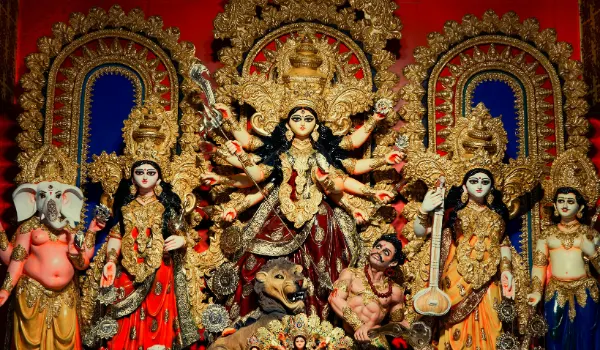Durga Puja is the most valuable cultural festival in West Bengal that celebrates the power of goddess Durga over buffalo demon Mahishasura. As much as the pandals (holy constructions) in Kolkata have made headlines throughout the world because of their grandeur and cleverness in their construction, Durga Puja extravagances are also held in West Bengal small towns. Such small and semi-urban communities offer a unique blend of tradition, a feeling of community and new artistic work which is often overshadowed by urban development. As we travel far and wide in this quest to understand Durga Puja pandals in small towns, we get to learn about their history and themes, build marvels of architecture, cultural relevance of the same, and its immense influences within the local communities.
1. The Historical Roots of Durga Puja in Small Towns
The background of Durga Puja can be found in the 16th century in Bengal. It started out as a family thing, but later became a community get together. Local clubs and associations established their own tradition in the small towns. Such grass-root groups were very instrumental in the arrangement of the celebrations, and in many cases the arrangement was done without many resources, and with a lot of passion.
The early pandals were very basic bamboo frames with cloths and leaves. These primitive arrangements over the decades evolved into grand spectacles as artistic and cultural cultures of the area developed.
Read also: West Bengal Cultural Festivals 2025: Complete Guide to Durga Puja, Poush Mela
2. Architectural Marvels: Crafting the Pandals
The creativity of local craftsmen is seen in the way the pandals are constructed in small towns. Craftsmen include references to the town and its surroundings in elaborate designs made of local materials (bamboo, jute and clay). As an example, in areas such as Durgapur and Andal, pandals are built based on nature, mythological and folklore subjects. It is demonstrated by the high-quality of the artwork of the craftspeople in the sculptures and decoration of the temporary structures.
3. Thematic Expressions: Beyond Tradition
Most small-town pandals have chosen modern and socially-conscious themes, whereas older themes revolved around the victory of Goddess Durga. These themes cut across issues like a clean environment, empowering women and community harmony. An early example is the Udayan Sangha of Purba Purbachal which has already presented themes such as: Removing the Veil of Superstition. These themes entertain them, educate and inspire them.
4. Cultural Significance: A Community Affair
Durga Puja are not only religious event in small towns, but a communal one also, and people in such small towns are together and are working together. The festival is scheduled several months ago and the locals organize a meeting to prepare, set up and decorate the pandals. Through this community participation, community bonds are enhanced and offer a medium through which local talent can be developed, whether in music, dance or drama performances to be staged during the festival.
5. The Role of Women and Youth
This has evidently led to a large number of women and youth involvement in the organisation and execution of Durga puja in small towns in the last few years. The different roles of the festival such as fundraising and cultural programs administration have been dominated by the women groups in the festival. The youth has come with new understandings that have brought new themes as well as new modes of conducting the traditional rituals to keep the festival alive to the young generations.
Read also: Durga Puja to Kali Puja: Celebrating Festivals Beyond Dashami
6. Environmental Consciousness: Sustainable Celebrations
Now that people have grown more aware of issues relating to the environment, environmentally friendly methods have been adopted in most small-town pandals. Measures being taken are the use of biodegradable materials as decorations, reduced use of plastic and encouraging burying of idols in artificial ponds. Such events not only help to minimize the environmental influence, but also provide a model of the celebratory world.
7. Culinary Delights: A Taste of Tradition
There is no Durga Puja festival that lacks its host of traditional Bengali foods. Small towns have numerous stalls of street food inside the pandal site, whose cuisines include mouth-watering foods such as: ashtrayi bhog (offerings to the goddess), mangsho (mutton curry), shorshe ilish (hilsa fish in mustard sauce), and mishti (sweets). These foodstuffs are part of the festivities and they present a flavor of the fine cuisine heritage of Bengal.
8. The Economic Impact: Boosting Local Economy
In small towns Durga Puja plays a major role in the local economy. The number of visitors during the festival increases the local businesses such as stores, restaurants and the transport sector. In addition, the festival offers jobs to the artisans, decorators, and performers and thus helps to sustain the lives of many people in the community.
9. Media and Documentation: Capturing the Essence
As a result of digital media, the special Durga Puja festivals in small towns are becoming more popular. The creativity and cultural diversity of these pandals are being displayed through social media, blogs and documentaries and drawing visitors all over the world. There are also local photographers and videographers who ensure such celebrations are captured so that the time to come can see and experience it.
10. Challenges and the Path Forward
The Durga Puja activities that occur in small towns, with all the fervour and industry, are threatened by lack of funds, infrastructural problems and environmental problems. However, fortunate enough they could be alleviated with the help of the community, Non-Governmental Organizations, and the local government. Investment can come through partnerships with urban counterparts, funding and government project departments to scale up the size and sustainability of these festivals.
Read also: Durga Puja Abroad: Keeping Bengali Festive Spirit Alive
Conclusion
The Durga Puja in West Bengal small towns with its own charm, tradition, inventiveness, and community spirit provides a wonderful and rich experience. Rarely taking a back seat to the metropolitan counterparts, these celebrations are an ode to the cultural heritage that Bengal has had. When we are enjoying the splendor Durga Puja, we must also acknowledge and understand what these small-town communities are doing. The commitment that they show makes the festival continue being a living stream in the Bengal cuisine.













